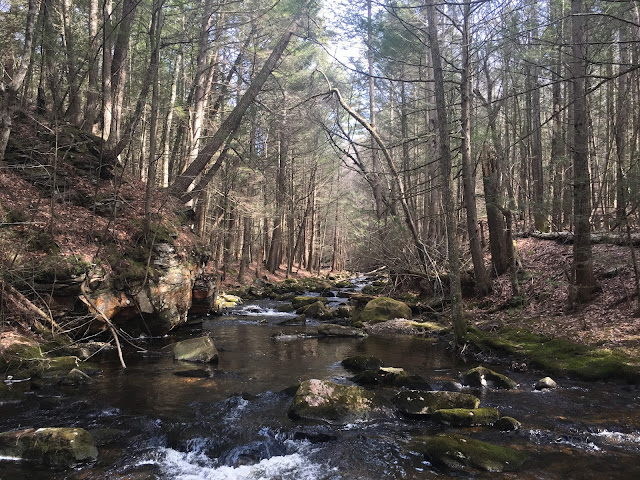If you've ever walked or fly fished along a New England trout stream, you've probably noticed the dense shade of some large evergreen trees along the banks. At first glance, they look like spruce or fir, but those species generally grow only at high altitudes. These special trees, guardians of trout streams, are Eastern Hemlocks.
 |
| A hemlock-lined stream in western Massachusetts |
Hemlocks prefer areas that are cool, shady, and moist, conditions met perfectly in the ravines formed by many small trout streams. Here the hemlocks grow, slowly but surely, for hundreds of years, ultimately reaching over 100 feet in the air with trunks over 5 feet in diameter. The dense needles of these mature trees provides shade year round - even on the brightest days it's surprisingly dark in a hemlock grove. This shade shields our trout streams from the warmth of the sun, helping to prevent temperatures from rising to levels lethal to brook trout.
 |
| Range of Eastern Hemlock |
Unfortunately, hemlocks are currently under threat. The
hemlock wooly adelgid is a parasitic insect species native to Japan. While its name may conjure up images of prehistoric beasts, it is formidable in its own right. It attaches to the base of a hemlock needle, then slowly robs the tree of its sap, ultimately leading to death. If you turn over a hemlock branch in Massachusetts, you're likely to see an adelgid on nearly every needle.
 |
| The adelgids are the puffy white balls on each needle |
As of right now, the most significant threat the adelgid poses is to hemlocks in the Southern Appalachians. Because it's native to a relatively moderate maritime climate in Japan, it can't survive extreme cold, so it hasn't spread much farther north than southern New England...yet. As the climate grows warmer, the adelgid will likely be able to spread northward. I've never seen any in the White mountains, but it's all over the hemlocks in my town near the MA/NH border. The cold winter of 2014/15 probably reduced the population to some degree, but this past winter was too warm to do much damage, so they could be farther north than ever before.
 |
| A brook trout caught in shade of hemlocks |
Fortunately, there is some hope. A study in the southern Appalachians found that while the death of hemlocks greatly increased the amount of light falling on headwater streams, temperatures in these streams were correlated more with proximity to groundwater sources than light levels (
Study Here - it's behind a paywall, but the conclusions are in the abstract). That means the brook trout should be able to survive, but as the climate continues to warm every little bit of shade could make a difference. The adelgid has also been subject to intensive research in recent years, and new control methods, including introduction of predatory beetles and application of pesticides, have shown some promise in reducing the population.
While it looks like trout will make it through regardless of what happens to the hemlock, I hope at least some hemlocks will survive. Even if the trout don't need the shade, there's nothing quite like fishing in a hemlock-forested ravine.





Very true. The hemlock is very important. Steps should be taken now by planting pine to take up where the hemlock will be lost.
ReplyDeleteThere are parts of the brook trouts native range where they are referred to as "hemlock trout"